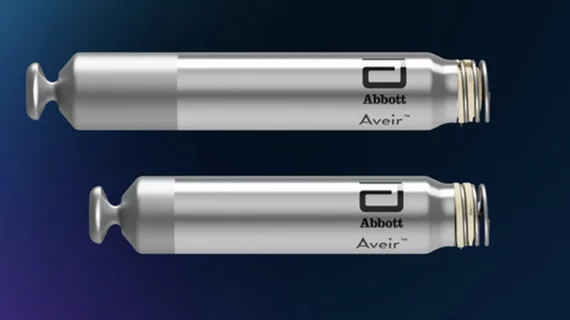Abbott announced the world's first patient implants of a dual-chamber leadless pacemaker system as part of its AVEIR DR i2 FDA pivotal clinical study. The implant of Abbott's investigational Aveir dual-chamber leadless pacemaker represents a significant technological milestone for leadless pacing technology. Current leadless pacing technology is limited to single chamber pacing, while most patients require dual-chamber pacing. If successful, this system will open up leadless pacemakers to a much larger group of patients.
The study is being co-chaired by Daniel J. Cantillon, MD, associate section head and research director of cardiac electrophysiology and pacing at Cleveland Clinic, and Reinoud Knops, MD, PhD, of the department of cardiology and electrophysiology at Amsterdam University Medical Center in the Netherlands.
Bradycardia patients may receive a pacemaker. Unlike traditional pacemakers, leadless pacemakers are implanted directly into the heart through a minimally invasive catheter-based procedure that eliminates the need for cardiac lead wires to a pacemaker can implanted under the skin. While leadless pacemakers work like traditional pacemakers to regulate heart rate, they offer reduced lead-related complications and a less restrictive recovery period due to the minimally invasive implant procedure.[1] Yet historically, leadless pacing options have been limited to single-chamber devices because synchronization of two leadless pacemakers has been very difficult to achieve.
Abbott said it solved this challenge by designing the company's innovative "i2i technology" to provide beat-by-beat communication between two leadless pacemakers, one positioned in the right ventricle and one positioned in the right atrium. This technology is designed to regulate the heart rate synchronously between chambers and allow for true dual-chamber leadless pacing.
The first implant was performed at Na Homolce Hospital in Prague, Czech Republic, led by site principal investigator Petr Neuzil, MD, PhD, head of the department of cardiology, and assisted by site co-investigator Vivek Y. Reddy, MD.
"The first-in-human implant of a dual-chamber leadless pacemaker is a major clinical milestone that will open up new possibilities for patients requiring pacing support," Cantillon said in a prepared statement. "Abbott has designed a device capable of treating these patients, and we're excited to see this technology advance patient care."
Abbott has focused significantly on driving leadless pacing technology that can potentially improve care for more patients battling abnormal heart rhythms. The latest milestone for the Aveir DR leadless pacemaker follows recent data showing that Abbott's investigational single-chamber leadless pacemaker – Aveir VR – met the pre-specified primary endpoints in its pivotal trial.[2]
"As leadless pacing technology has evolved, we've always viewed dual chamber leadless technology as a therapy evolution that would have a dramatic impact on more patients – but a technology that was going to be very challenging to develop," Knops explained. "That we've reached this point in time where dual chamber pacing without leads has become a reality is a monumental moment for modern medicine."
Because nearly 80% of people who receive a pacemaker need a dual-chamber option to pace both chambers on the right side of the heart, Aveir DR has been designed to address a critical need for these patients. Abbott also designed the Aveir DR leadless pacemaker to be retrievable, so the system can be replaced or retrieved as therapy needs evolve. The Aveir DR system is designed to provide real-time mapping capability so physicians can assess therapy delivery and reposition the device before implant during a patient's procedure.
About the Aveir DR i2i study
Abbott also shared additional information about the Aveir DR i2i study:
The Aveir DR i2i study (also known as the LEADLESS II IDE Study) is a prospective, multicenter, international, single-arm, pivotal investigational study designed to evaluate the clinical safety and efficacy of the Aveir DR leadless pacemaker in patients who were indicated for a DDD(R) – or dual-chamber bradycardia pacing – pacemaker, which stimulates the appropriate chamber of the heart when clinically necessary. The study plan is to enroll up to 550 patients from up to 80 sites in the U.S., Canada, Europe and Asia-Pacific, and all patients will be followed for a minimum of 12 months post-implant.
The Aveir DR i2i leadless pacemaker is an investigational device being clinically evaluated as part of a global pivotal study and is not yet commercially available. The device design specifications are subject to change.
Related leadless pacemaker content:
Leadless devices reduce infections in pacemaker-dependent patients
FDA highlights safety issue with leadless pacemakers, focusing on Medtronic’s Micra
FDA approves world’s smallest pacemaker with AV synchrony
Implantable pacemaker market slated to top $5.3B by 2023
References:

